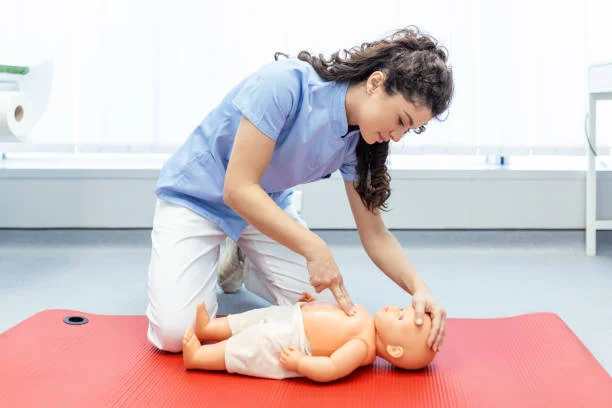Timely Cardiopulmonary Resuscitation (CPR) can improve the survival rate of a patient from 10.2% – 15.4%. So, in such an emergency, when a patient is between life and death, you can be the one to save a life with immediate CPR. Thus, hands-on practice using adult and pediatric models allows healthcare providers to respond quickly and effectively during such medical emergencies. In this blog, we will discuss the components of CPR for healthcare providers, its benefits, and how it can improve your impact in emergency settings.
Dive deeper into topics you love—check out these carefully selected related posts.
What is CPR for Healthcare Providers?
CPR for healthcare providers is an advanced life-saving program designed for medical professionals that follows the guidelines of the American Heart Association (AHA). It teaches how to perform high-quality chest compressions and deliver rescue breathing to maintain blood flow and oxygen circulation in patients experiencing choking or cardiac or respiratory arrest. The course also trains providers to recognize life-threatening emergencies, use an automated external defibrillator (AED), and manage patients of all ages, including infants, children, and adults. Unlike Community CPR, this program focuses on the clinical precision and teamwork required in hospital and emergency care settings.
Who Should Take the CPR Course?
This training is recommended for licensed healthcare professionals and emergency responders who may need to provide life-saving interventions during critical situations. The following professionals in the medical field can take it:
● Nurses
Intended for nurses working in Intensive Care Units, Emergency Rooms, and step-down units to manage sudden cardiac arrests effectively. CPR training allows them to deliver high-quality chest compressions and ventilation as an immediate response before advanced help arrives.
● Doctors and Physician Assistants
Physicians in emergency medicine, anesthesiology, or cardiology must master CPR protocols for quick intervention. Their role includes leading resuscitation teams and making time-sensitive decisions that can improve the survival of a patient.
● Paramedics and Emergency Medical Technicians
As the first line of responders, they depend on these skills to improve survival outcomes before the patient is taken to the hospital. Training in CPR allows them to stabilize patients during pre-hospital care, thus preventing organ damage.
● Dentists and Oral Surgeons
Those performing procedures under sedation also require the knowledge of CPR in case of respiratory or cardiac cases. Rapid intervention during dental surgeries can prevent fatal anesthesia-related complications.
● Respiratory Therapists
Responsible for airway management, they need CPR training to handle respiratory arrest effectively. Their ability to maintain the flow of oxygen and ventilation is crucial during operations.
● Medical and Nursing Students
CPR certification is mandatory before entering clinical rotations for patient safety during emergencies. Training at such an early stage helps develop confidence and competence, which makes them a real asset for their future roles.
Note: CPR certification is commonly required for professionals working in emergency departments, intensive care units (ICUs), operating rooms, dental clinics, and ambulance services.
CPR Course Objectives
The CPR course allows medical professionals to respond quickly to save lives during cardiac and respiratory emergencies, as it combines theory with practical skills using adult and pediatric models. After completing this course, you will be able to do the following:
- Perform CPR on infants, children, and adults.
- Deliver rescue breaths and manage airways.
- Use an Automated External Defibrillator (AED) during resuscitation.
- Provide bag-mask ventilation for 2-rescuer CPR cases.
- Recognize early signs of choking, cardiac arrest, and respiratory arrest.
- Work as part of a resuscitation team in a clinical setting.
Overview of the CPR Course Curriculum
The course, CPR for healthcare providers covers a broad curriculum that includes theoretical understanding with hands-on training. Here’s a look at the core topics:
| Core Topic | Description |
| Adult and Pediatric CPR | Step-wise approach to compressions and breathing techniques. |
| AED Application | Proper pad placement and defibrillation process. |
| Airway Management | Clearing obstructions in the airway and using bag-mask ventilation. |
| Two-Rescuer Techniques | Coordinated CPR for better outcomes. |
| Team Dynamics | Enhancing communication, coordination, and leadership during emergencies. |
Importance of Practicing on Adult and Pediatric Models
CPR is a psychomotor skill; it requires practical training with muscle coordination, which cannot be implemented through theory alone. Thus, effective performance requires hands-on practice. Working on adult and pediatric models provides an opportunity to develop the correct method of execution. Moreover, this is how practical knowledge helps:
- Improves muscle memory for accurate compressions and ventilations.
- Allows correct compression depth and rate for adequate circulation during cardiac arrest.
- It helps maintain an open airway and deliver rescue breaths.
- Builds confidence in providing ventilation without gastric inflation.
- Helps adapt to age-specific differences in anatomy.
Thus, the hands-on component of this course serves as a key differentiator, improving a medical professional’s ability to perform effectively during an emergency.
Benefits of CPR for Healthcare Providers
Obtaining a CPR certification is more than just a job requirement; it provides healthcare professionals with the skills that can save lives. Listed below are five benefits:
● Improves Patient Survival Rates
Immediate and effective CPR significantly increases the chances of survival for patients experiencing cardiac or respiratory arrest, making this training indispensable for healthcare professionals.
● Enhances Clinical Competence
Certification allows the mastery of life-saving techniques, including chest compressions, airway management, and the usage of an Automated External Defibrillator (AED), thus strengthening overall clinical expertise.
● Prepares for Real-World Emergencies
Practice on adult and pediatric models prepares providers to respond quickly and effectively in high-pressure, unpredictable scenarios within hospitals or clinics.
● Promotes Teamwork and Communication
CPR training emphasizes coordination among team members during resuscitation efforts, improving workflow, and reducing errors in critical care situations.
● Increases Professional Credibility
Certification demonstrates a commitment to patient safety and continuous learning, enhancing trust and career advancement opportunities in healthcare settings.
Strengthen Your Role in Life-Saving Care
Healthcare professionals act as the first line of defense during cardiac or respiratory emergencies. Thus, completing a CPR certification course allows you to provide high-quality care across all age groups when lives are at stake. As clinical guidelines evolve, maintaining your CPR certification keeps your expertise current and relevant in the healthcare industry.
To enhance your clinical performance, advance in your career, or simply ensure patient safety, CPR for healthcare providers is an essential investment in your professional growth.
So, are you ready to make a difference? Start your CPR training today and take the first step toward saving lives with confidence.
Venture further—explore more articles that capture trends and insights you need.






